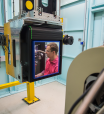Advanced materials research
New oxygen ion conducting material for use in solid oxide fuel cells and other devices

Showing 141 - 160 of 239 results
New oxygen ion conducting material for use in solid oxide fuel cells and other devices
ANSTO's unique capabilities are being used to develop a quick analytical tool to determine the geographic origin of seafood and authenticates quality.

The High Performance Macromolecular Crystallography beamline will enable the study of very small (sub-5 micrometre) or weakly diffracting crystals, providing a state-of-the-art high-throughput facility for researchers. MX3 will be able to study the structures of large proteins and protein complexes for virology, drug design and industrial applications via goniometer mounted crystals, in-tray screening, or via serial crystallography methods.
ANSTO waste management services meet regulatory requirements and international best practice standards.
An accomplished international photographer has capture dazzling new images of one component of the main ring at our Australian Synchrotron and provided an inside view of the electron’s path when it is used.
With a well-established portfolio of nuclear research and the operation of Australia's only nuclear reactor OPAL, ANSTO scientists conduct both fundamental and applied research on fuel for current, advanced, and future nuclear technology systems.
In 2023 we’re celebrating the 70th Anniversary since Australia began developing our nation’s Australia’s nuclear capabilities.
Come and discover the world of nuclear science at ANSTO - book a school tour in Sydney today.
Environmental Scientist Amy Macintosh is researching the impact of the petroleum industry on Australian marine life.
ANSTO is a unique national science organisation that began operating under its predecessor The Australian Atomic Energy Commission (AAEC) 70 years ago.
A sparrow with 257 parts weighing more than 29 tonnes arrives safely at ANSTO
A new nuclear medicine waste processing facility that showcases ANSTO Synroc technology is under construction.
ANSTO researchers have taken up the challenge to develop a coating for the cladding used in nuclear reactors to prevent it from taking up hydrogen and releasing it if temperatures get too high and repair itself if damaged.
Over the past 70 years ANSTO has been building Australia’s nuclear expertise and despite being small in scale, today we are complex and sophisticated nuclear nation.


The first demonstration of reversible symmetry lowering phase transformation with heating.